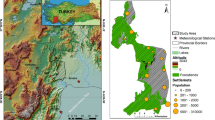Abstract
The degree at which tropical forests are exposed to human pressure is spatially dependent. Population density, proximity to roads, terrain slope, logging activities and land distribution projects are well known factors inducing deforestation and forest degradation in Latin America. Using expert knowledge to weight these threat factors and a Geographical Information System for spatial modeling, a multi-criteria analysis procedure is presented, that allows stratifying a study region in categories of deforestation threat. The procedure was implemented in the Central Volcanic Mountain Range Conservation Area (CVMRCA) in Costa Rica with the purpose of finding areas with a combination of physical and socioeconomic characteristics that is particularly predisposing to a high probability of deforestation. To validate the map, the CVMRCA was stratified in categories of deforestation risk, and the result was superposed to historical deforestation data of the period 1986–1996. The good correlation between risk category and historical deforestation (r = 0.91, p < 0.001) indicates that the map can be used as a decision support tool for defining priority areas for conservation action.
Similar content being viewed by others
References
Achard, F., Eva, H. D., Glinni, A., Mayaux, P., Stibig, H.-J., & Richards, T. (1998). Identification of deforestation hot spot areas in the humid tropics. TREES Publications Series B, Research Report No.4, European Commission, Luxembourg. Online at http://www.gvm.sai.jrc.it/Forest/, reviewed 11/25/2003.
Achard, F., Eva, H. D., Stibig, H.-J., Mayaux, P., Gallego, J., & Richards, T., et al. (2002). Determination of deforestation rates of the world’s human tropical forests. Science, 297, 999–1002.
Dirzo, R., & Garcia, M. C. (1992). Rates of deforestation in Los Tuxtlas, a neotropical area in southeast Mexico. Conservation Biology, 6, 84–90.
Foundation for the Development of the Central Volcanic Mountain Range (Fundecor) (1988). Land use map of the Central Volcanic Mountain Range, 1986.
Foundation for the Development of the Central Volcanic Mountain Range (Fundecor) (2003a). Environmental Education Program. Online at http://www.Fundecor.or.cr/educacion/programa/accvc/, reviewed 11/25/2003.
Foundation for the Development of the Central Volcanic Mountain Range (Fundecor) (2003b). Fundecor and its forest conservation strategy: a global innovative approach. Online at http://www.Fundecor.or.cr/acerca/, reviewed 11/25/2003.
Gilruth, P. T., Marsh, S. E., & Itami, R. (1995). A dynamic spatial model of shifting cultivation in the highlands of Guinea, West Africa. Ecological Modelling, 70, 179–197.
Green, G. M., & Sussman, R. (1990). Deforestation history of the eastern rainforests of Madagascar from satellite images. Science, 248, 212–215.
Léclerc, G., & Rodríguez, J. C. (1998). Using a GIS to determine critical areas in the Central Cordillera Conservation Area, Costa Rica. In B.G. Savitsky, & T. E. Lacher Jr. (Eds.) GIS methodologies for developing conservations strategies: tropical forest recovery and wildlife management in Costa Rica (pp. 108–126). New York, NY: Columbia University Press.
Ludeke, A. K., Maggio, R. C., & Reid, L. M. (1990). An analysis of anthropogenic deforestation using logistic regression and GIS. Journal of Environmental Management, 31, 247–257.
Malczewski, J. (1999). GIS and multicriteria decision analysis. New York: Wiley (392 p).
Moran, E. F., Brondizio, E., Mausel, P., & Wu, Y. (1994). Integrating Amazonian vegetation, land-use, and satellite data. BioScience, 44, 329–338.
Ortiz, E., Lewandoski, A., Castañeda, F., Tattenbach, F., Herrere, C., Umaña, R. I., et al. (1992). Informe de Avance, Estrategia Global, Área de Conservación Cordillera Volcánica Central, MIRENEM, USAID, FUNDECOR, San José, Costa Rica (Technical report), 41 p.
Pedroni, L. (2003). Improved classification of Landsat RM data using modified prior probabilities in large and complex landscapes. International Journal of Remote Sensing, 24, 91–113.
Saaty, T. L. (1977). A scaling method for priorities in hierarchical structures. Journal of Mathematical Psychology, 15, 234–281.
Saaty, T. L. (1980). The analytic hierarchy process pp. 559–563. New York: McGraw-Hill Encyclopedia of Science & Technology.
Sader, S. A. (1995). Spatial characteristics of forest clearing and vegetation regrowth as detected by Landsat Thematic Mapper imagery. Photogrammetric Engineering and Remote Sensing, 61, 1145–1151.
Sader, S. A., & Joyce, A. T. (1988). Deforestation rates and trends in Costa Rica: 1940–1983. Biotropica, 20, 11–19.
Stone, T. A., Brown, I. F., & Woodwell, G. M. (1991). Estimation, by remote sensing, of deforestation in central Rodonia, Brazil. Forest Ecology and Management, 38, 291–304.
Utting, P. (1991). The social origins and impact of deforestation in Central America, Discussion paper 24, United Nations Research Institute for Social Development, 43 p.
Veldkamp, E., Weitz, A. M., Staritsky, I. G., & Huising, E. J. (1992). Deforestation trends in the Atlantic zone of Costa Rica: a case study. Land Degradation and Rehabilitation, 3, 71–84.
Author information
Authors and Affiliations
Corresponding author
Rights and permissions
About this article
Cite this article
Pedroni, L., Imbach, P. & Rodríguez, J. Finding threatened forest areas in the central volcanic mountain range conservation area in Costa Rica. Environ Monit Assess 141, 245–255 (2008). https://doi.org/10.1007/s10661-007-9892-y
Received:
Accepted:
Published:
Issue Date:
DOI: https://doi.org/10.1007/s10661-007-9892-y




